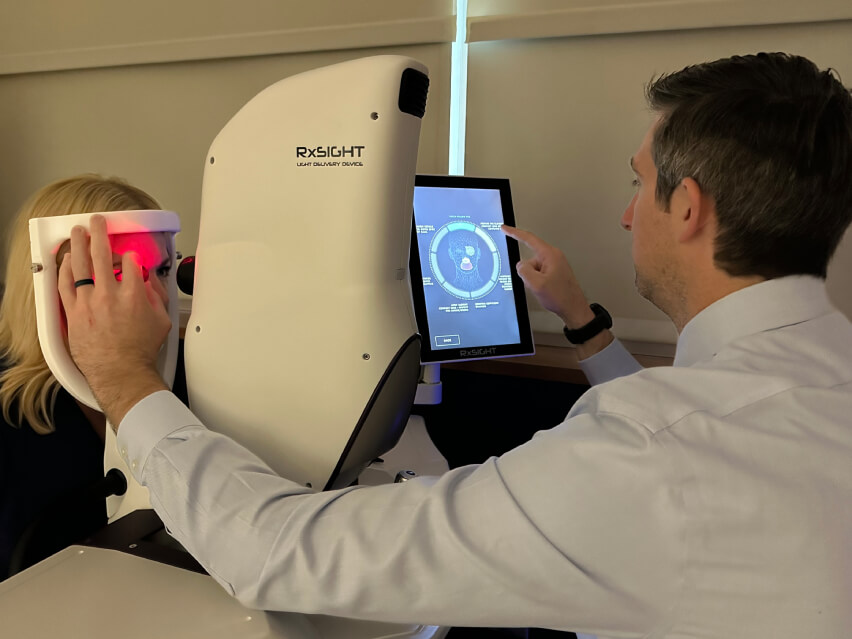Cataracts
Medical Optometry America Helps You Monitor & Manage Your Cataracts
Cataracts are one of the most common eye conditions in the world. Most people will eventually experience some cataract formation with age. However, cataracts do not need to keep you from living your life.
Medical Optometry America doctors work with you to accommodate your changing visual needs. We can keep your visual performance at the highest level possible, either by changing your prescription or exploring your candidacy for cataract surgery when lens correction is no longer effective.
With the development of new intraocular lens technologies for cataract surgery, it is critical to stay informed about the best potential choices for your rehabilitation. Your Medical Optometry America clinician will help you understand your options so you can select the best surgeon for your needs.

Introducing the groundbreaking Light Adjustable Lens (LAL), the most innovative intraocular lens (IOL) designed for patients who want more precise control of their vision after cataract surgery. Unlike other IOLs, the LAL is fully customizable, as it’s adjusted three weeks after your cataract surgery is finished to give you perfect vision after your procedure. The cutting-edge technology behind these lenses utilizes a special photo responsive material that can be shaped and reshaped using non-invasive light treatments. This means that patients can enjoy perfect vision, often achieving 20/20 without glasses or additional refractive surgery.
MOA is proud to partner with the best cataract surgeons in the greater Philadelphia region to offer post-operative adjustments for the LAL. After your surgeon removes your cataract and implants the LAL, our doctors perform adjustments to optimize the lens to your exacting visual needs. MOA Light Adjustment Specialists were among the first optometrists in PA trained on the adjustments and have already performed over 500 to date.
Are you a Good Candidate for LAL?
Good candidates for LALs typically include patients who:
- Want to avoid dependence on glasses.
- Who want LASIK-like results.
- Have previously had refractive surgeries such as LASIK and PRK.
- Are really particular about their vision.
Schedule your appointment today to find out if you’re a good candidate for the LAL.
Learn More About Cataracts and LAL Lenses
From Our Expert Doctors
Understanding Cataracts
What Are Cataracts?
Your eye’s natural crystalline lens is composed of evenly spaced proteins that allow light to pass through them easily. As you age, these proteins restructure and start to cluster closer together in any part of the lens. This process makes it more difficult for light to pass through, creating a cloudy haze over your vision.
When the proteins restructure like this, it is called a cataract. Any discoloration, haziness, or opacification of your natural lens is considered a cataract.
Will I Get Cataracts?
Most people will develop cataracts eventually, and most people over 40 already have at least some cataract development.
Certain genetic, health, and lifestyle factors can put you at risk for developing cataracts earlier in life. For example, diabetes, obesity, smoking, excessive sunlight exposure, high blood pressure, and previous eye injuries can all contribute to cataract development.
What Are Symptoms of Cataracts?
Symptoms of cataracts can include:
- Glare or halos around lights
- Significant difficulties with night vision
- Frequent need for a stronger prescription
- Cloudy or blurry vision
- Dull or yellowed color vision
Our Recommended Treatments
- Ongoing monitoring and management
- Adjusted prescriptions
- Lifestyle modifications
- Cataract surgery
Cataracts & Surgical Co-Management
During the early stages of cataract development, your optometrist will most likely increase your eyewear prescription to help keep your cataracts from impacting your lifestyle. However, once cataracts begin to significantly obscure your vision, we normally recommend surgery to remove them. Cataract surgery is typically performed in an outpatient setting and the patient returns home after the procedure.
The operation begins by making a small incision in the side of the cornea. Then, using either a laser or an ultrasonic device, the ophthalmologist gently removes the affected lens and replaces it with an artificial intraocular lens, or IOL. The IOL functions the same way your natural lens does, and provides excellent postoperative visual performance in almost all cases.
Significant advances in IOL technology over the last decade now give you the ability to select one of several IOLs to meet your individual visual needs. Medical Optometry America optometrists work together with clinical leaders in ophthalmology and will carefully guide you through this process to promote the best possible outcome.
Our patients typically report nearly full visual clarity after recovering from cataract surgery. You may or may not need glasses after cataract surgery depending on the type of IOL you select.



